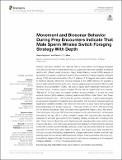Files in this item
Movement and biosonar behavior during prey encounters indicate that male sperm whales switch foraging strategy with depth
Item metadata
| dc.contributor.author | Isojunno, Saana | |
| dc.contributor.author | Miller, Patrick | |
| dc.date.accessioned | 2018-11-28T09:30:06Z | |
| dc.date.available | 2018-11-28T09:30:06Z | |
| dc.date.issued | 2018-11-28 | |
| dc.identifier | 256528491 | |
| dc.identifier | 8f544040-4527-475a-a3de-6d924f6289d1 | |
| dc.identifier | 85057466098 | |
| dc.identifier | 000451950100001 | |
| dc.identifier.citation | Isojunno , S & Miller , P 2018 , ' Movement and biosonar behavior during prey encounters indicate that male sperm whales switch foraging strategy with depth ' , Frontiers in Ecology and Evolution , vol. 6 , 200 . https://doi.org/10.3389/fevo.2018.00200 | en |
| dc.identifier.issn | 2296-701X | |
| dc.identifier.other | ORCID: /0000-0002-2212-2135/work/51261021 | |
| dc.identifier.uri | https://hdl.handle.net/10023/16563 | |
| dc.description | This work was funded by NL Ministry of Defense, NOR Ministry of Defense, US Office of Naval Research (N00014-08-1-0984, N00014-10-1-0355, N00014-14-1-0390), and FR Ministry of Defense (DGA) (public market n°15860052). | en |
| dc.description.abstract | Despite their apex predator role, relatively little is known about the foraging strategies that deep-diving marine mammals employ to target prey resources available at different depths with different costs of access. Using hidden Markov model (HMM) analysis of behavioral time series, we aimed to quantify the potential for multiple foraging strategies during 3150 terminal echolocation (‘buzz’) phases of 28 tagged male sperm whales in Northern Norway. Movement metrics included in the HMM reflected the predator’s pursuit path (vertical velocity, pitch and heading variance) and locomotion effort (overall dynamic body acceleration ODBA). We found a highly depth-dependent distribution of four buzz types: “Shallow-sparse” (median 161 m) had the highest inter-buzz intervals, “Mid-active” (372 m) were the longest duration buzzes (median 21 s) and the most active in terms of pitch variance, heading variance and ODBA, while “Deep” and “Deep descent” buzzes (1130-1180 m) were the shortest in duration (~7 s) and least energetic in maneuvers. Regression models for acoustic metrics with both buzz type and depth as explanatory variables revealed that maximum click rate in a buzz had a strong negative linear relationship with ambient pressure (1.2 Hz every 10 atm or 100 m). After accounting for the effects of pressure, buzz click rates were significantly higher during “Mid-active” than other types of buzzes. Within buzzes, apparent click output level (AOL, off-axis level received by the tag, dB re 1 μPa) correlated linearly with log10(inter-click-interval), as expected by acoustic gain control and increasing sensory volume with increasing click rate. These results indicate that while higher acoustic sampling rates were used to track more mobile prey, buzz clicks were produced more sparingly at high ambient pressures where the number of pneumatically produced clicks may be limited before air must be recycled, and where prey seem easier to subdue. The diverse prey base indicated by this study support the feeding requirements of large male sperm whales, and that high feeding rates of more densely distributed and perhaps more predictable resources (e.g. immobile life stages of female Gonatus fabricii) likely maintain preference for the deepest foraging habitats (> 1 km) of this generalist predator. | |
| dc.format.extent | 15 | |
| dc.format.extent | 12954106 | |
| dc.language.iso | eng | |
| dc.relation.ispartof | Frontiers in Ecology and Evolution | en |
| dc.subject | Buzz | en |
| dc.subject | Dtag | en |
| dc.subject | Hidden Markov model | en |
| dc.subject | Sound production | en |
| dc.subject | Pressure effects | en |
| dc.subject | Prey switching | en |
| dc.subject | QH301 Biology | en |
| dc.subject | DAS | en |
| dc.subject | SDG 14 - Life Below Water | en |
| dc.subject.lcc | QH301 | en |
| dc.title | Movement and biosonar behavior during prey encounters indicate that male sperm whales switch foraging strategy with depth | en |
| dc.type | Journal article | en |
| dc.contributor.sponsor | Office of Naval Research | en |
| dc.contributor.institution | University of St Andrews. School of Biology | en |
| dc.contributor.institution | University of St Andrews. Sea Mammal Research Unit | en |
| dc.contributor.institution | University of St Andrews. Scottish Oceans Institute | en |
| dc.contributor.institution | University of St Andrews. Marine Alliance for Science & Technology Scotland | en |
| dc.contributor.institution | University of St Andrews. Institute of Behavioural and Neural Sciences | en |
| dc.contributor.institution | University of St Andrews. Centre for Social Learning & Cognitive Evolution | en |
| dc.contributor.institution | University of St Andrews. Bioacoustics group | en |
| dc.contributor.institution | University of St Andrews. Centre for Research into Ecological & Environmental Modelling | en |
| dc.identifier.doi | https://doi.org/10.3389/fevo.2018.00200 | |
| dc.description.status | Peer reviewed | en |
| dc.identifier.grantnumber | N00014 08 1 0984 | en |
This item appears in the following Collection(s)
Items in the St Andrews Research Repository are protected by copyright, with all rights reserved, unless otherwise indicated.

